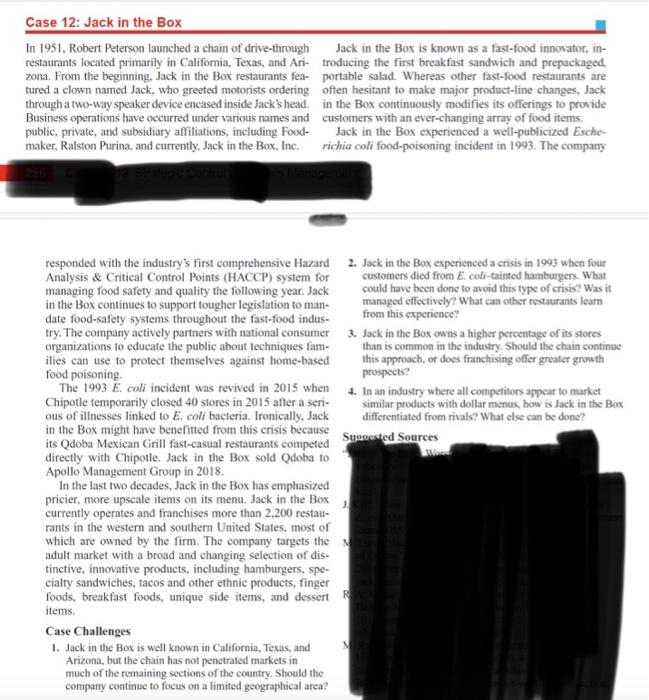Answered step by step
Verified Expert Solution
Question
1 Approved Answer
In 1951, Robert Peterson launched a chain of drive-through restaurants located primarily in California, Texas, and Arizona. From the beginning, Jack in the Box restaurants
In 1951, Robert Peterson launched a chain of drive-through
restaurants located primarily in California, Texas, and Arizona.
From the beginning, Jack in the Box restaurants featured
a clown named Jack, who greeted motorists ordering
through a two-way speaker device encased inside Jacks head.
Business operations have occurred under various names and
public, private, and subsidiary affiliations, including Foodmaker,
Ralston Purina, and currently. Jack in the Box, Inc.
Jack in the Box is known as a fast-food innovator, introducing
the first breakfast sandwich and prepackaged,
portable salad. Whereas other fast-food restaurants are
often hesitant to make major product-line changes, Jack
in the Box continuously modifies its offerings to provide
customers with an ever-changing array of food items.
Jack in The Box experienced a well-publicized Escherichia
coli food-poisoning incident in 1993. The company
responded with the industrys first comprehensive Hazard
Analysis & Critical Control Points (HACCP) system for
managing food safety and quality the following year. Jack
in the Box continues to support tougher legislation to mandate
food-safety systems throughout the fast-food industry.
The company actively partners with national consumer
organizations to educate the public about techniques families
can use to protect themselves against home-based
food poisoning.
The 1993 . coll incident was revived in 2015 when
Chipotle temporarily closed 40 stores in 2015 after a serious
of illnesses linked to E. coli bacteria. Ironically, Jack
in the Box might have benefited from this crisis because
its Qdoba Mexican Grill fast-casual restaurants competed
directly with Chipotle. Jack in the Box sold Qdoba to
Apollo Management Group in 2018.
In the last two decades, Jack in the Box has emphasized
pricier, more upscale items on its menu. Jack in the Box
currently operates and franchises more than 2,200 restaurants
in the western and southern United States, most of
which are owned by the firm. The company targets the
adult market with a broad and changing selection of distinctive,
innovative products, including hamburgers, specialty
sandwiches, tacos and other ethnic products, finger
foods, breakfast foods, unique side items, and dessert
items.
Case Challenges
1. Jack in the Box is well known in California, Texas, and
Arizona, but the chain has not penetrated markets in
much of the remaining sections of the country. Should the
company continue to focus on a limited geographical area?
2. Jack in the Box experienced a crisis in 1993 when four
customers died from E. co/i-tainted hamburgers. What
could have been done to avoid this type of crisis? Was it
managed effectively? What can other restaurants learn
from this experience?
3. Jack in the Box owns a higher percentage of its stores
than is common in the industry. Should the chain continue
this approach, or does franchising offer greater growth
prospects?
4. In an industry where all competitors appear to market
similar products with dollar menus, how is Jack in the Box
differentiated from rivals? What else can be done?

Step by Step Solution
There are 3 Steps involved in it
Step: 1

Get Instant Access to Expert-Tailored Solutions
See step-by-step solutions with expert insights and AI powered tools for academic success
Step: 2

Step: 3

Ace Your Homework with AI
Get the answers you need in no time with our AI-driven, step-by-step assistance
Get Started


